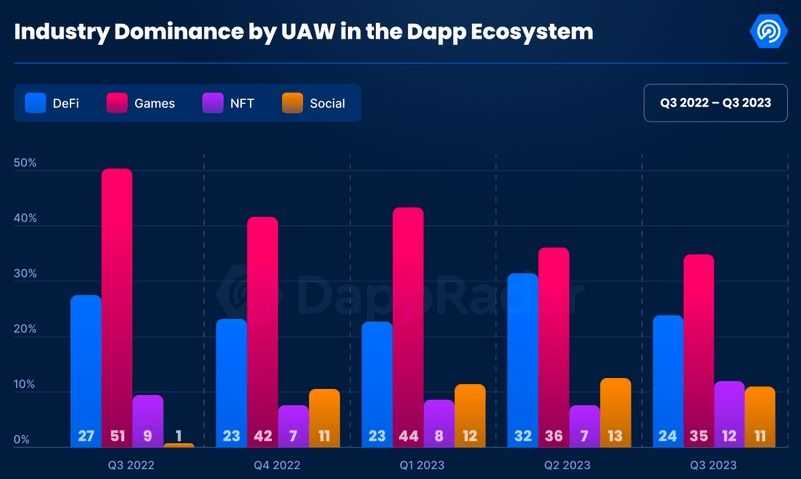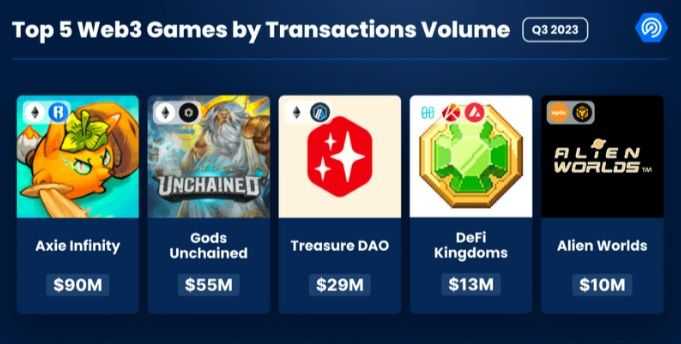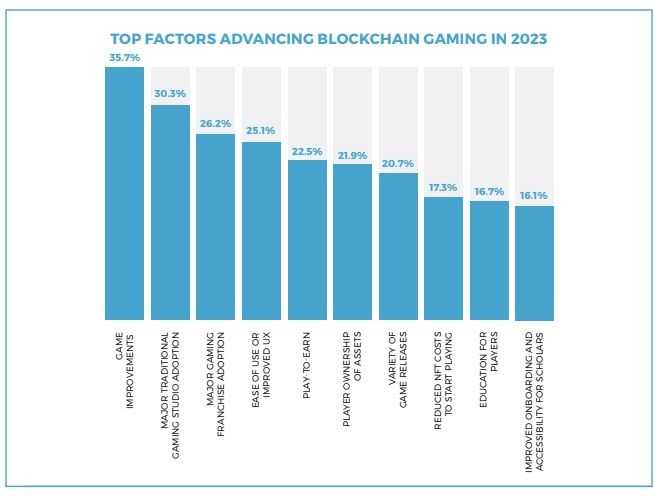My gaming journey began with the Nintendo Entertainment System (NES). Those early days, spent mastering games like Bomberman, navigating the Mushroom Kingdom with Mario, and taking aim in Duck Hunt (and listening to the annoying laughter of that dog), were more than just moments of entertainment — they were the foundation of what would become a lifelong hobby.
As the years passed and I ventured into adolescence, my gaming preferences evolved. Shooter games became my newfound love, offering challenges that demanded precision, strategy and quick reflexes. But gaming was more than just having a higher K/D ratio, and it soon evolved into a social activity. LAN parties became a regular occurrence, transforming weekends into gaming marathons that stretched into the wee hours of the morning.
From the pixelated screens of the NES to the current generation, the evolution of gaming has been extraordinary. Now, with the rise of play-to-earn games (P2E), gaming has taken yet another transformative leap. P2E games differ considerably from traditional games, allowing players to explore virtual realms and offering them an opportunity to earn tangible rewards.
P2E games challenge traditional gaming models and are reshaping the way we perceive interactive entertainment. Yet, amidst the excitement and fervour, questions linger: Will play-to-earn games ever achieve mainstream adoption? What obstacles stand in the way of their widespread acceptance, and what factors could potentially propel them into the gaming mainstream?
In this analysis, we embark on a journey to unravel the intricate layers of play-to-earn games. We will dissect the core mechanics that underpin these virtual ecosystems, examine the challenges that have hindered their progress, and explore solutions that could pave the way for their integration into the daily lives of traditional gamers.
What Are Play-to-Earn Games?
In P2E crypto games, players aren't just consumers, but active participants in a virtual economy.
Unlike traditional games, where the time and effort invested rarely translate into real-world value, P2E games offer players the opportunity to monetize their gaming skills and time. P2E gamers can earn rewards, such as cryptocurrencies or NFTs, tokens native to the game or in-game assets, by engaging in various activities within the game. These digital rewards hold real-world value and can be traded, sold, or converted into fiat money.
Powering this gaming revolution is blockchain technology which ensures transparency, security, and ownership of various rewards within P2E ecosystems.
How Do Play-To-Earn Games Work?
P2E games take the opposite approach to traditional gaming, which employs a pay-to-play mantra where you get access to the game by paying a flat amount. If you've got an itch in your pocket, you can choose to pay a little extra money for in-game items (like a shiny new gun skin and new characters) or access to extra content. It's important to note that these items are cosmetic in that they do not change the gameplay in any way.
Game developers have the creative freedom to design in-game economies and establish rules for asset distribution and transfers among users. The incorporation of non-fungible tokens (NFTs) adds a sense of collectability and novelty to games, enhancing their appeal to players.
While in-game currency and asset collection are common in free-to-play and pay-to-play games, traditional game currencies and items remain confined within the game environment. Blockchain-based games, on the other hand, offer a more immersive experience by granting players complete ownership, ensuring provable scarcity, and enabling transparent tracking of in-game assets.
The Rise of Play-to-Earn Games
According to DappRadar, blockchain games are the undisputed king of the DApp realm.

Cryptokitties was one of the first blockchain games to attract widespread attention. Launched in 2017 on Ethereum, players purchase, breed and trade virtual cats with different visual features of varying levels of rarity. The virtual cats are static images, and the game has no goal.
The P2E gaming market has since continued to grow. In the third quarter, blockchain games fetched $600 million in funding, taking the year's tally to $2.3 billion. By the end of 2027, P2E games are expected to generate revenue of $65.7 billion.
Today, Axie Infinity is the largest Web3 game with a total volume of $90 million as of the third quarter of 2023.

In Axie Infinity, players battle, breed, collect, raise, and build kingdoms for their Axies, which are in-game creatures that can be collected as pets. There's an in-game economy where players can buy, sell and trade resources they earn in the game.
Traditional game publishers have dipped their toes into Web3 gaming as well. Ubisoft, a French publisher famous for its Assassin's Creed and Far Cry gaming franchises, announced Ubisoft Quartz, which lets players earn and purchase NFTs based on the Tezos blockchain. However, other publishers enticed by the potential of P2E have had to reverse course following an uproar from their player base.
Challenges to Mainstream Adoption
The Web3 gaming vertical may be the fastest-growing DApp niche, but there are still challenges that need to be addressed to reach mainstream adoption.
As noted, games that implemented P2E model gained considerable traction even as their gameplay may be considered stagnant by traditional gamers. However, during times of market turmoil and token price fluctuations, the model may not be as sustainable as initially thought.
Another hurdle is the gameplay itself. Most P2E games lack the immersive storytelling that sets traditional games apart, stopping Web2 gamers from jumping ship.
Let's explore some of the problems plaguing crypto games.
Player Onboarding and Accessibility
According to a survey by the Blockchain Gaming Alliance (BGA) that explored trends in 2022, over half of the respondents cited onboarding and accessibility as the biggest hindrance to mainstream adoption of Web3 games.
To participate in blockchain gaming, users first have to create and manage their wallets. This, of course, means having to deal with seed phrases and private keys. The process can be daunting and confusing for the uninitiated. All of these factors combine to create a higher barrier of entry compared to traditional games where you can go from zero to slaying monsters within a minute.
To put that into perspective, here's the fiat-on-ramp for Defi Kingdom, a gamified decentralized exchange.

Mirko Doelger, the CEO of Web3 game development company Unix Gaming, perhaps put in best.
Blockchain game developers should understand that games need to work for the player. We need to go through the hoops necessary to attract players, rather than demand the player jump through hoops to play the game. The fact is, if your blockchain game can’t provide a comparable or superior experience, you’re out. - Blockchain Gaming Alliance
Game Design
For blockchain games, the problem starts at the beginning.
Play-to-earn games are designed around the game's tokens and NFTs. A vast majority of the players are attracted toward the potential to make money. Driving this design philosophy is the underlying concepts of digital property rights and decentralization. As noted, blockchain games offer players the opportunity to own digital assets such as NFTs and tokens as in-game rewards that are tradable. The developers of these games monetize through secondary sales of NFTs, marketplace fees and creator royalties.
Games designed around an in-game economy where money matters more than the player experience don't tend to sit so well with most traditional gamers.
The traditional gaming industry has “microtransactions” too. The term was coined in 2006 and offered cosmetic purchases as an add-on that didn't affect the gameplay in any manner. The idea was to enhance the players' experience for a small fee. While most gamers scoffed, these microtransactions were modestly successful for Bethesda, which is said to have started the trend. Today, microtransactions rake in tens of billions of dollars each year.
In the context of blockchain games, the monetization model heavily relies on secondary sales of NFTs, marketplace fees, and creator royalties. While this approach offers financial incentives to both developers and players, it shifts the focus from the intrinsic joy of gaming to the pursuit of financial gains, creating a divide between the gaming experiences of traditional and crypto gamers.
Gameplay
Gameplay distinguishes good games from truly exceptional ones. While visually impressive graphics and compelling narratives are important, it is the gameplay mechanics that breathe life into a game, transforming it from a mere pastime into a captivating adventure. For me, the fusion of challenge, reward and player engagement is what makes video games transcend other forms of entertainment.
However, when it comes to crypto games, this vital ingredient often falls short, hindering their mainstream adoption. Despite the allure of blockchain technology and the potential for real-world earnings, many crypto games struggle to deliver satisfying gameplay experiences. According to the same BGA survey, a significant 37.2% of respondents cited poor gameplay as a major reason for the low mainstream adoption of blockchain games.
In many crypto games, the focus on blockchain integration and monetization models often overshadows the essential elements of fun, strategy, and balanced competition. Players need to feel challenged, rewarded, and emotionally invested in the game world. The absence of these fundamental gameplay principles can lead to a disconnect, leaving players unsatisfied and disinclined to continue their gaming journey within the crypto space.

In the BGA survey, 35.7% of respondents said gameplay improvements would be the industry's top priority in 2023.
Security Concerns
The fusion of crypto and blockchain technology in a gamified environment brings forth a host of potential vulnerabilities.
- Smart Contract Vulnerabilities: Crypto games rely on smart contracts to facilitate in-game transactions. However, vulnerabilities within these contracts can be exploited. Flaws in coding, lack of rigorous auditing, or unforeseen interactions between contracts can create opportunities for malicious actors to manipulate the game's economy.
- Phishing Attacks: Malicious entities can create fake websites or apps resembling legitimate game platforms. This can trick players into revealing their private keys or login credentials.
- Data Privacy Concerns: The decentralized nature of blockchain technology often implies transparency, but it can raise concerns about data privacy. Players may be apprehensive about their personal information being stored on public ledgers, especially when it comes to in-game transactions.
- Asset Theft: Some crypto games allow players to trade in-game assets on centralized exchanges. However, these exchanges can be susceptible to hacks (and they have been), resulting in the theft of players' valuable items and cryptocurrencies.
In 2021, crypto gaming platform Vulcan Forged suffered a $140 million breach after a hacker exploited the platform and gained access to the private keys of 96 wallets. A year later, The Sandbox said it would migrate its LAND smart contracts after it discovered a vulnerability.
Limited Earnings Potential
For a vast majority of players engaging with P2E games, the pull lies in the potential to earn real-world value through digital assets and cryptocurrencies. However, players often find themselves facing limited earning opportunities within the Web3 gaming ecosystem.
Several factors determine your earnings potential.
- Market Volatility: Fluctuations in the value of cryptocurrencies directly impact the real-world value of in-game assets and earnings. Depending on which direction the price moves, the value of assets earned can decrease significantly or lead to increased profits.
- Transaction Fees: Most blockchain networks charge fees for processing transactions, including those related to in-game trades and transfers of assets. These high fees can eat into profits.
- Game-Specific Rewards Structure: Each P2E game has its own rewards structure. Some may offer more lucrative rewards for specific in-game activities or achievements.
- Skills and Competition: Players with superior skills and strategies often earn more. Players who excel in gameplay, complete challenging tasks, or win competitions can earn rare and valuable in-game assets, which can be traded or sold for profits.
A player spent six months experimenting with various P2E games and found out that for the most part, they ended up losing money than making a profit. Of course, you'll find accounts online of people minting Benjamins.
The earning potential of these play-to-earn games has mostly benefitted those in developing countries such as the the Philippines, where there are stories of gamers being able to buy houses from the Axie Infinity earnings.
The Web2 Perspective: How to Overcome These Challenges
Despite their innovative approach that marries blockchain and gaming, crypto games are faced with challenges that hinder their journey towards mainstream adoption.
To navigate these hurdles, the blockchain gaming industry can draw insights from the enduring successes of traditional AAA titles. The traditional gaming sector has long been synonymous with high-quality productions, immersive storytelling, and unmatched player experiences.
Immersive Gameplay and Storytelling
The most famous traditional AAA games are renowned for their immersive storytelling, captivating narratives and solid gameplay. Engaging storylines create emotional connections, making players invested in the game world and its characters. Games like "The Last of Us" and "Red Dead Redemption 2" are often used as examples of compelling stories and character development.

Games with exceptional gameplay mechanics possess a timeless quality that invites players to revisit their worlds repeatedly. Titles like "The Legend of Zelda" encourage exploration, experimentation, and creativity, offering an expansive gameplay experience. This freedom promotes diverse playstyles and ensures ever-lasting appeal aka replayability.
Crypto games can elevate their appeal by investing in compelling narratives and building immersive universes that players are eager to explore again and again. By crafting compelling stories, Web3 games can encourage players to invest more time and energy into the gaming experience.
One of the most promising looking AAA crypto game is Star Atlas, which is leveraging the powerful Unreal 5 engine for cinema-like graphics and the playable demos and beta launches are already looking “next-gen.” This game is one certainly worth watching, we cover it in detail in our Star Atlas review.
Fair Monetization Models
One of the pivotal lessons that blockchain games can glean from the AAA gaming sector is the implementation of monetization models.
Traditional games have largely moved away from pay-to-win mechanics. Instead, they focus on monetization strategies that enhance player experiences without compromising game balance. This shift has fostered inclusive gaming economies, where players can participate and enjoy the game without feeling disadvantaged due to their financial investment.
For blockchain-based games, fair monetization models hold the key to bridging the gap between blockchain enthusiasts and mainstream gamers. By steering away from exploitative pay-to-win mechanics, crypto games can build trust and credibility among players.
I think the lovers of the original P2E model will always exist, creating demand signals for studios. However, it will be hard for studios to ignore the profitability of a game that captures the casual everyday gamer in the traditional gaming space. - BGA
This quote, courtesy of Mirai Labs co-founder Corey Wilton, signifies a pivotal moment in the crypto gaming industry where studios must strike a balance between catering to the enthusiasts who appreciate the core principles of P2E and expanding their audience to include casual gamers. Ignoring the profitability and appeal of games designed for casual everyday gamers could mean missing out on a significant revenue stream and a chance to achieve widespread adoption.
User Experience and Accessibility
User experience is an all-encompassing term that can make or break a game's success. Let's take a deep dive.
- Intuitive User Interfaces: Creating an intuitive UI is the first step toward ensuring a positive gaming experience. Players should be able to go through different menus, manage their in-game inventories, and execute in-game actions effortlessly.
- Simplified Onboarding Processes: The initial onboarding experience sets the tone for a player's entire journey within a game. For P2E games, which often involve setting up digital wallets and understanding blockchain concepts, simplifying the onboarding process is essential.
- Accessibility Features: Ensuring that games are accessible to players with diverse abilities is a fundamental aspect of user experience. Incorporating accessibility features such as customizable controls, subtitles, colourblind modes, and adjustable difficulty levels accommodates a wider range of players.
AAA games excel in creating seamless user experiences. By prioritizing user experience, crypto games can break down barriers, making their platforms welcoming and approachable for players of all backgrounds.
In the BGA survey, respondents identified ease of use or improved user experience as one of the top factors that can push the industry forward.
Take a Player-First Approach
Traditional gamers' disdain toward the P2E model is deeply rooted in the gaming community's aversion to the idea that financial prowess can substitute for genuine skill and effort.
I can tell you clearly where this disdain for crypto comes from. The hatred comes from these play-to-earn games that pioneered blockchain gaming. - Cointelegraph
Traditional gamers appreciate the grind as long as it occurs on fairgrounds. When a game deviates from this principle and allows players to gain significant advantages by simply pouring money, the essence of fair competition is disrupted. Because of this thinking, a vast majority of traditional gamers have chosen to stay on the sidelines.
The previously explored play- to-earn models have proven themselves unsustainable but drew the attention needed for the next, more mature wave of blockchain gaming dynamics to be formed. This wave of development will be less speculative and form a more substantial value-add to the gaming experience. - BGA
The call to ditch, or at least reassess, the P2E model underscores the industry's imperative to preserve the values that have defined gaming for decades. Instead of monetizing through in-game assets and transactions, crypt gaming studios should explore alternative revenue streams that do not compromise the sanctity of the gaming experience.
Web2 Studios' Foray into Web3 Gaming
For many traditional gaming studios, crypto gaming has become too sexy to ignore.
Established gaming giants' foray into blockchain-based games holds immense promise for the crypto gaming ecosystem, and the Web3 gaming industry is well aware of it.
I believe that, as blockchain technology is streamlined, becoming more scalable, easier to implement and more sustainable, adoption by traditional gaming companies will be key in developing the player-centric applications that will lead to adoption by mainstream users. - BGA
Bandai Namco, Square Enix, Epic Games and Ubisoft are some of the traditional players that have been smitten by the potential of Web3 gaming. According to the BGA survey, adoption by major gaming studios is believed to be a key factor in driving the industry forward, making up over half of the respondents’ answers combined.
Here's how this paradigm shift could potentially revolutionize crypto gaming.
Expertise and Innovation
Traditional gaming studios have decades of experience and expertise. As they look to join the crypto gaming sphere, they bring with them a wealth of knowledge about game design, mechanics and player engagement. This infusion of expertise could result in the creation of high-quality gaming experiences within the crypto space. Their innovative approaches, honed through years of crafting successful titles, would breathe new life into blockchain games, elevating them to a standard that appeals to a broader audience base.
Enhanced Production Values
A vast majority of crypto games have embarrassingly bad graphics. Traditional gaming studios, however, are renowned for their deep pockets, which translate into eye-popping, high-fidelity graphics.
In a report on its decision to block Microsoft's acquisition of Call of Duty-producer Activision Blizzard, the UK's Competition and Markets Authority noted that games with a release window of 2024 and 2025 have development budgets of $200 million or higher, with some games even exceeding the $300 million mark. By comparison, a Web3 game costs a fraction of that — various accounts online put it between $60,000 to $300,000 depending on numerous elements. The CMA eventually approved the deal after Microsoft made some concessions and the deal has since closed.
By applying these high production values to crypto games, the industry would witness a significant improvement in the visual appeal, narrative depth, and overall experience. This enhancement should not only attract more players but also contribute to the legitimacy of crypto gaming.
Recognition and Adoption
The involvement of established gaming studios would lend some much-needed credibility to the crypto gaming sector in the eyes of mainstream audiences. Players who were previously hesitant about venturing into blockchain-based games would potentially be more open to exploring the world of Web3 games when they see trusted gaming brands endorsing the technology.
In addition to recognition, the collaboration between traditional studios and crypto gaming ventures is also instrumental in breaking down barriers and attracting a diverse player base. As these players delve into blockchain games endorsed by well-known studios, they become integrated into the ever-expanding crypto-gaming community. This influx of new players would not only diversify the player base but also fuel the industry's expansion.
Innovative Monetization Models
Traditional gaming studios have decades of knowledge about player preferences and monetization strategies. Their innovative monetization models are where this influence is most evident. Traditional gaming studios, well aware of player expectations and desires, can introduce a new approach to monetization that ideally doesn't eat into profits and keeps players satisfied.
Traditional studios pioneered microtransactions. Unlike the contentious pay-to-win mechanics prevalent in some crypto games, ethical microtransactions offer players the opportunity to make small, optional purchases that enhance their gaming experience without compromising gameplay balance. This ensures that players willingly invest in their gaming experience, contributing to the game's financial viability without compromising the game's integrity.
The Future of Crypto Gaming
In a recent gathering of The Coin Bureau's creme de la creme in sunny Dubai, a statement from our editor-in-chief, Tayler McCraken, struck a chord with me.
Tayler recounted a conversation he had with a friend who owns a PlayStation gaming console but remained blissfully unaware of its intricate workings. “There could be magic fairies in there for all I know. I don't care how it works, I just want to play games” his friend remarked. This anecdote encapsulates a profound truth: It is the practical applications and user experiences, not the underlying technology, that will fuel the widespread adoption of cryptocurrencies and crypto gaming.
The analogy, inspired by a casual conversation between two friends, extends to crypto gaming and captures a fundamental truth — players do not want to grapple with complicated processes when trying to enjoy a game. Much like the journey of going from turning on a gaming console to immersing yourself in gameplay without pondering the underlying complexities, crypto games must take a no-hassle approach.
While innovative and revolutionary, blockchain tech should operate behind the scenes, enhancing the gaming experience for all players without imposing a steep learning curve. The objective should be to eliminate the perception of blockchain as an intricate web of protocols and transactions, allowing gamers to focus solely on the thrill of the game.
So, is the remedy to what ails crypto gaming a Web3 gaming console? Zilliqa certainly seems to think so.

In September 2022, the Layer-1 blockchain took the wraps off a hardware console and gaming hub. Zilliqa touted its user-friendliness and Web3 capabilities, which include a crypto wallet and mining integrated into it. Most importantly, the company said the console would “hide the complexity of Web3 from the end-user.” While the console was expected to launch in early 2023, that hasn't happened yet.
Observers think the industry will largely move from P2E games and shift to Free to Play to Earn — games that do not require players to purchase an expensive NFT to play. There's also chatter about new methods of monetization.
- Players could earn rewards for successful invites to the game
- Users' online habits will be recorded on the blockchain and will then be used to achieve advertising revenue
- The sale of live streaming and broadcasting rights, and then rewarding the community through the appreciation of token values
Regardless of how this eventually pans out, the key to widespread adoption lies in simplification for both crypto gaming and the wider crypto ecosystem. Just as players do not ponder the intricacies of their gaming consoles before indulging in gameplay, crypto games should offer an experience where players can effortlessly transition from the real world to the blockchain-enabled gaming world.
Although there has been some disdain from the traditional gaming community regarding the inadequacies of many existing blockchain games, and rightfully so perhaps, there are some pretty amazing crypto games already being enjoyed by players or some coming down the pipeline. Check out our article on the 8 Best Crypto Games to see which ones are exciting us and the 10 blockchain games that shaped the past year.
Closing Thoughts
Crypto gaming has the potential to revolutionize the gaming industry, yet it is faced with challenges in achieving mainstream adoption. Play-to-earn games, powered by blockchain technology, have garnered attention for their ability to offer players real-world earnings and ownership of in-game assets. However, several obstacles, such as complex onboarding processes, lacklustre gameplay, security concerns, and limited earning potential, have hindered their widespread acceptance.
To overcome these challenges, the industry must prioritize immersive gameplay and storytelling. By creating compelling narratives and engaging experiences, crypto games can establish emotional connections with players. Additionally, adopting fair monetization models that avoid pay-to-win mechanics and prioritize player experience is crucial. Traditional gaming studios, with their wealth of expertise in different areas, can play a significant role in shaping the future of crypto gaming.
Simplification and user-friendliness are paramount. Just as players seamlessly dive into traditional gaming experiences without pondering the underlying technology, crypto games should offer a hassle-free experience. The complexity of blockchain technology should operate behind the scenes, enhancing the gaming experience without imposing a steep learning curve on players.
While challenges persist, the potential for crypto gaming remains promising. By prioritizing user experience, eliminating unnecessary hurdles, and ensuring intuitive gameplay, crypto games can capture the essence of gaming: an immersive, enjoyable adventure that requires no mental gymnastics, allowing players to focus on what truly matters — the game itself.
Frequently Asked Questions
Play-to-earn games, also known as P2E games, are blockchain-based video games that allow players to earn real-world rewards, such as cryptocurrencies, tokens, or in-game assets, by participating in various activities within the game. Unlike traditional games, P2E games enable players to monetize their gaming skills and time, offering tangible value for their in-game achievements.
Play-to-earn games face several challenges, including complex onboarding processes, lack of immersive gameplay, security concerns, and limited earning potential. Additionally, some players are wary of the pay-to-win mechanics prevalent in certain P2E games. Overcoming these challenges and simplifying the user experience are essential steps toward mainstream adoption.
Traditional gaming studios bring decades of experience, innovative approaches, and high production values to the crypto gaming industry. Their expertise can enhance the overall quality of crypto games, making them more appealing to a broader audience. Traditional studios can also introduce fair monetization models and collaborate with blockchain gaming ventures to create engaging and immersive gaming experiences.
Disclaimer: These are the writer’s opinions and should not be considered investment advice. Readers should do their own research.


